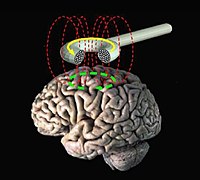
Photo from wikipedia
Is it possible for an Artificial Intelligence (AI) model to match the performance of clinicians in prescribing the first dose of follitropin? The AI based Decision Support System (DSS) we… Click to show full abstract
Is it possible for an Artificial Intelligence (AI) model to match the performance of clinicians in prescribing the first dose of follitropin? The AI based Decision Support System (DSS) we developed identifies accurately the optimal starting dose range of follitropin and prospectively matches the clinicians’ performance. Most patients treated by IVF undergo Controlled Ovarian Stimulation (COS). Based on their ovarian markers, demographic characteristics, and clinical history, an initial dose of follitropin is prescribed. Failing to tailor correctly this dose can result in a suboptimal ovarian response, leading on the one hand to low and ineffective response or, on the other, to excessive and dangerous stimulation. AI methods can learn from large databases of COS results and generate predictive models to assist the clinicians in optimizing this decision. A database of 2713 first IVF cycles from 5 clinics, from 2011 to 2019 was used to develop the model. Predictor variables included: age, BMI, AMH, FSH, LH, estradiol, Antral Follicular Count (AFC), infertility etiology, and previous live births. 80% of the database was used to train the algorithm, and 20% to test the DSS. Additional 524 cycles from a different period (2020–2021) were used for prospective validation. Follitropin dosage was divided in 4 categories: 100–150IU, 151–200IU, 201–250IU, and >250IU. An optimal ovarian response is defined as retrieving 10–15 MII, whenever the patient ovarian reserve allows it. To predict the optimal dose range personalized to each patient, the DSS uses a Random Forest model learned with training cycles. To evaluate the DSS performance, a score for each dose range and each patient was defined given the prescribed doses and the corresponding ovarian responses. The cycles included in the database were from women 37.2±4.9 years old [18–45], with a BMI of 23.7±4.2, AMH of 2.4±2.3, AFC of 11.8±7.7; the average number of oocytes and MII obtained was 10.1±7.1 and 7.2±5.3, respectively. The DSS achieved a performance mean score of 0.88 in the testing database, a value significantly better than the one calculated for the doses prescribed by the clinicians, which had a mean score of 0.83 (p-value <0.05). In the validation database the mean performance score of the DSS recommendations was 0.87, and there were no significant differences with the score of the doses actually prescribed by clinicians, also with a score of 0.86. With these results the model was shown to at least match the performance of the human doctor. It is worthy of note that the performance score value for the doses prescribed by clinicians in the validation database is relevantly higher than in the test database, closing the gap previously existing with the DSS performance. As the validation cycles are separated temporally from the rest of the cases and correspond to the newer ones, it is plausible to infer that a more experienced clinical staff would perform better. The DSS prospective validation should be extended to more clinical cases to ensure higher reliability. Hyper-responders were underrepresented in the database which can lead to less accurate recommendation in some of these women. As all AI models, the DSS should be tested prospectively before clinical application. Wider implications of the findings: The AI based clinical Decision Support System that we developed could be deployed as a training and learning tool for new clinicians and serve as quality control for experienced ones; further, it can be used as an electronic second opinion, for instance by providing information in peer-to-peer case discussions. Not applicable
Journal Title: Human Reproduction
Year Published: 2021
Link to full text (if available)
Share on Social Media: Sign Up to like & get
recommendations!